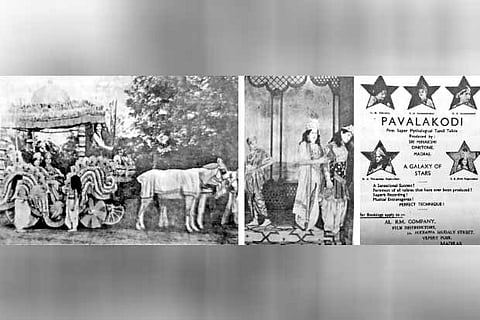

Chennai
The epic, Mahabharata, with its various sub stories was a favourite for theatre in Tamil Nadu. Each region in the State developed scripts on Arjuna’s exile according to their own traditions, which had absolutely no connection with Veda Vyasa’s original.
Capitalising on the soft corner the archer had for pretty women, the stories had him travelling to imaginary lands where he wooed beautiful princesses. Alli Rani and Pavalakodi were two of such stories in Tamil street plays and theatre.
Pavalakodi, the literal meaning of which is the Coral Queen, enacts the mythical romance between Arjuna and Pavalakodi, the princess of Coral Island.
It was originally a successful stage play performed out by an ensemble who toured all over Tamil Nadu, Ceylon, Malaya and Singapore, where the play was staged several hundred times.
The hero was the upcoming stage actor MK Thyagaraja Bhagavathar, whose voice made the audience go into a delirium. The heroine was SD Subbulakshmi, who is also credited with having mentored her namesake MS Subbulakshmi in her early singing and cinema days.
When the play was making waves, the Tamil films had begun speaking for the first time in 1931. For those filmmakers, the popular stage plays were the obvious choice to adapt for the nascent medium.
Pavalakodi was made in 1934, with Thyagaraja Bhagavathar – or MKT as he was popularly known – and SD Subbulakshmi reprising their roles. It was the first film for both of them. Coincidentally for MKT, Pavalakodi play that was staged in 1926 at Ponmalai in Tiruchy marked his debut in plays.
When the drama was playing in Salt Quarters Royal Theatre, SM Letchumanan Chettiar (popularly called Lena), a prominent businessman dealing in used automobiles as well as a patron and contractor for drama troupes in Chettinad, was among those in the audience.
He decided to bankroll the project to make a talkie based on the same story. K Subramanyam, a fresh law graduate for whom films were an obsession and had worked in silent films, directed the film. Much later, he would become a key figure behind the establishment of the Tamil film industry.
It was agreed that the film would be shot in Madras, on the banks of the Adyar river just across the lush forests of the Theosophical Society of India.
On that land, Meenakshi Cinetone was established, which later went on to create history in cinema and politics when MG Ramachandran bought it to establish Sathya Studio. Thyagaraja Bhagavathar and SD Subbulakshmi were hired, for Rs 4,000 and Rs 2,500 respectively.
In the 1930s when it was under production, filmmaking was rather rudimentary. Studio were without a roof to enable sunlight to stream in. Most of the filming was done outdoors using sunlight, and breaks were called when it became cloudy. For moving shots, the camera was mounted on a cart.
But there was no shortage of money when it came to preparing sets. Even in those days, setting up a durbar cost Rs 5,000, and used to have 50-100 artistes as ‘extras’.
There were 55 songs in the film, with a live orchestra performing from a tree shade while actors mouthing it out in the sun. Some outdoor shooting was held in the Theosophical Society as well.
Shooting a talkie was more complicated that a silent film. There should be no sounds at all when the camera started rolling. This, however, was a challenging task. With so many actors and crew, there was plenty of food waste being strewn around the spot.
This brought in crows in large groups, and the ensuing cacophony disturbed the shooting. Finally, an Anglo Indian man named Joe was recruited to scare off the crows by shooting from his rifle every now and then. Acknowledging his important role in the making of the film, the film credits name him as “Joe the Crow Shooter”.
There was another disruptive element that Joe could not train his gun at: Sivasubramanian, a partner who was hell bent on disrupting the production. Restrained by a court order from entering the premises, he used to park his car outside the perimeter and honk the car horn to disrupt proceedings till his share was bought out.
Many a time, it came close to stopping the movie. Following the advice by an astrologer, the producer withheld money, and the director and lead actors had to return a part of their advances to keep the shooting going.
Exceeding the brief given in the script, MKT, the hero, often used to kiss the stunned heroines (there were three of them) which was not in the script.
In those days when the country was under the British, a sudden kiss on the lip did not bother the censors, who were more anxious about references to the crown and the empire. But MKT kept well away from Subbulakshmi - the director Subramanyam married SDS soon afterwards.
Running for almost 300 days and quite well on reruns as well, Pavalakodi was one of the earliest successful Tamil films, which helped establish this as a profit-making industry.
It turned the attention of investors to this new field, encouraging them to loosen their purse strings. It also established MKT as the first superstar of Tamil cinema, who delivered a hit with his debut film.
—The author is a historian
Visit news.dtnext.in to explore our interactive epaper!
Download the DT Next app for more exciting features!
Click here for iOS
Click here for Android